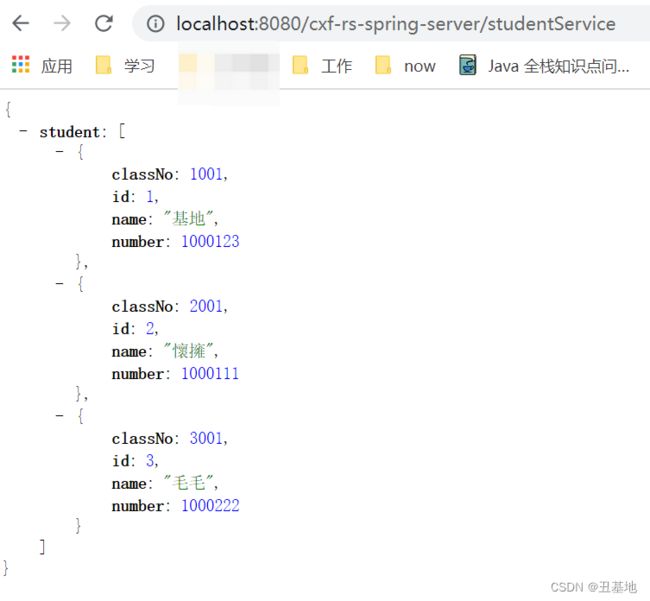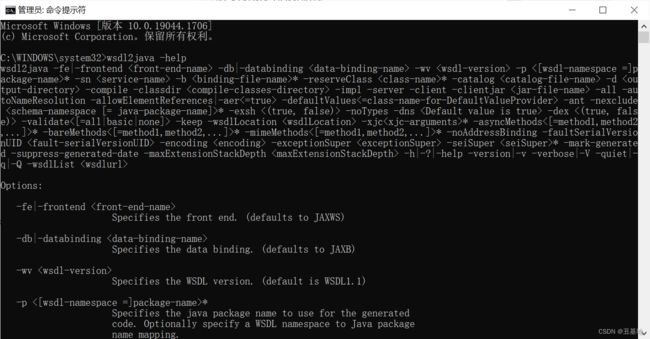webservice服务调用
目录
- 一、简介
-
- 1、什么是 Web Service?
- 2、Web Service三要素
-
- 2.1、SOAP
-
- 2.1.1、SOAP协议格式
- 2.2、WSDL
- 2.3、UDDI
- 3、开发规范
-
- 3.1、JAX-WS
- 3.1、JAX-RS
- 4、应用场景
-
- 4.1、优缺点
- 4.2、适用场景
- 二、Web Service 实战
-
- 1、基于JAX-WS规范的 Web Service 构建
-
- 1.1、基于原生CXF实现
-
- 1.1.1、服务端
- 1.1.2、客戶端
- 1.2、Spring整合CXF实现
-
- 1.2.1、服务端
- 1.2.2、客户端
- 1.3、Spring Boot整合CXF实现
- 2、基于JAX-RS规范的 Web Service 构建
-
- 2.1、基于原生CXF实现
-
- 2.1.1、服务端
- 2.1.2、客户端
- 2.2、spring整合CXF实现
-
- 2.2.1、服务端
- 2.2.2、客户端
- 2.3、Spring Boot整合CXF实现
- 三、调用第三方服务
一、简介
1、什么是 Web Service?
Web Service是一种跨编程语言和操作系统平台的远程调用技术。Web Service采用标准的SOAP(Simple Object Access Protocol,简单对象访问协议,属于w3c标准。并且是基于 http 的应用层协议传输xml数据)协议传输。Web Service采用WSDL作为描述语言,并且W3C为Web Service制定了一套传输数据类型,使用xml进行描述,即XSD(XML Schema Datatypes),任何语言写的web Service 接口在发送数据的时候都要转换成WebService标准的XSD发送。
2、Web Service三要素
Web Services 平台的元素:
- SOAP(简易对象访问协议);
- UDDI(通用描述、发现及整合);
- WSDL(Web services 描述语言)。
2.1、SOAP
SOAP也叫做简单对象访问协议,是一种简单的基于xml的协议,它使应用程序通过HTTP来交换数据,可以简单的理解为SOAP= http+xml。SOAP协议目前的主流版本为:SOAP1.1和SOAP1.2。SOAP也不是Web Service的专有协议,其它的应用程序也可以用soap传输数据。
2.1.1、SOAP协议格式
一条 SOAP 消息就是一个普通的 XML 文档,包含下列元素:
- 必需的 Envelope 元素,可把此 XML 文档标识为一条 SOAP 消息;
- 可选的 Header 元素,包含头部信息;
- 必需的 Body 元素,包含所有的调用和响应信息;
- 可选的 Fault 元素,提供有关在处理此消息所发生错误的信息。
所有以上的元素均被声明于针对 SOAP 封装的默认命名空间中:http://www.w3.org/2001/12/soap-envelope,以及针对 SOAP 编码和数据类型的默认命名空间:
http://www.w3.org/2001/12/soap-encoding。
SOAP 消息的基本结构如下:
<soap:Envelope
xmlns:soap="http://www.w3.org/2001/12/soap-envelope"
soap:encodingStyle="http://www.w3.org/2001/12/soap-encoding">
<soap:Header>
...
soap:Header>
<soap:Body>
...
<soap:Fault>
...
soap:Fault>
soap:Body>
soap:Envelope>
2.2、WSDL
WSDL(网络服务描述语言,Web Services Description Language)是一门基于 XML 的语言,用于描述 Web Services 以及如何对它们进行访问(方法,入参,返回值)。简单地说就是Web Service的使用说明书。
WSDL文档结构主要包括5个标签:
:服务视图,Web Service的服务结点,它包括服务端点; :为每个服务端口定义消息格式和协议细节; :最重要的 WSDL 元素,它可描述一个 web service、可被执行的操作,以及相关的消息,可以把 元素比作传统编程语言中的一个函数库(或一个模块、或一个类); :定义一个操作的数据元素,每个消息均由一个或多个部件组成。可以把这些部件比作传统编程语言中一个函数调用的参数; :定义 web service 使用的数据类型,为了最大程度的平台中立性,WSDL 使用 XML Schema 语法来定义数据类型。
下面是一个 WSDL 文档的简化的片段:
<!--定义数据类型-->
<wsdl:types>
<s:schema elementFormDefault="qualified" targetNamespace="http://WebXml.com.cn/">
<s:element name="getMobileCodeInfo">
<s:complexType>
<s:sequence>
<s:element minOccurs="0" maxOccurs="1" name="mobileCode" type="s:string"/>
<s:element minOccurs="0" maxOccurs="1" name="userID" type="s:string"/>
</s:sequence>
</s:complexType>
</s:element>
<s:element name="getMobileCodeInfoResponse">
<s:complexType>
<s:sequence>
<s:element minOccurs="0" maxOccurs="1" name="getMobileCodeInfoResult" type="s:string"/>
</s:sequence>
</s:complexType>
</s:element>
</s:schema>
</wsdl:types>
<!--定义操作的数据元素-->
<wsdl:message name="getMobileCodeInfoSoapIn">
<wsdl:part name="parameters" element="tns:getMobileCodeInfo"/>
</wsdl:message>
<wsdl:message name="getMobileCodeInfoSoapOut">
<wsdl:part name="parameters" element="tns:getMobileCodeInfoResponse"/>
</wsdl:message>
<!--定义可执行的操作-->
<wsdl:portType name="MobileCodeWSSoap">
<wsdl:operation name="getMobileCodeInfo">
<wsdl:documentation xmlns:wsdl="http://schemas.xmlsoap.org/wsdl/"><br /><h3>获得国内手机号码归属地省份、地区和手机卡类型信息</h3><p>输入参数:mobileCode = 字符串(手机号码,最少前7位数字),userID = 字符串(商业用户ID) 免费用户为空字符串;返回数据:字符串(手机号码:省份 城市 手机卡类型)。</p><br /></wsdl:documentation>
<wsdl:input message="tns:getMobileCodeInfoSoapIn"/>
<wsdl:output message="tns:getMobileCodeInfoSoapOut"/>
</wsdl:operation>
</wsdl:portType>
<!--定义消息格式和协议细节-->
<wsdl:binding name="MobileCodeWSSoap" type="tns:MobileCodeWSSoap">
<soap:binding transport="http://schemas.xmlsoap.org/soap/http"/>
<wsdl:operation name="getMobileCodeInfo">
<soap:operation soapAction="http://WebXml.com.cn/getMobileCodeInfo" style="document"/>
<wsdl:input>
<soap:body use="literal"/>
</wsdl:input>
<wsdl:output>
<soap:body use="literal"/>
</wsdl:output>
</wsdl:operation>
</wsdl:binding>
<!--定义服务端点-->
<wsdl:service name="MobileCodeWS">
<wsdl:port name="MobileCodeWSSoap" binding="tns:MobileCodeWSSoap">
<soap:address location="http://ws.webxml.com.cn/WebServices/MobileCodeWS.asmx"/>
</wsdl:port>
</wsdl:service>
2.3、UDDI
UDDI(Universal Description, Discovery and Integration),通用描述、发现与集成服务,通过它,企业可注册并搜集Web Service。企业将自己提供的Web Service注册在UDDI,也可以使用别的企业在UDDI注册Web Service服务,从而达到资源共享。UDDI旨在将全球的Web Service资源进行共享。
3、开发规范
3.1、JAX-WS
JAX-WS(Java API for XML-Based Web Service):一个远程调用可以转换为基于XML协议(例如:SOAP协议),在使用JAX-WS过程中,开发者不需要使用任何代码来编写生成和处理SAOP。JAX-WS运行时会自动将这些API调用转换为SAOP协议的消息。
在服务端,通过Java语言定义远程调用所需要实现的接口(SEI:Service EndPoit Interface),并对其提供相关的实现,通过调用JAX-WS的服务来发布接口就可以发布一个Web Service 服务。
在客户端,通过JAX-WS的API来创建一个代理来(用本地代理对象来替代远程的服务对象)实现远程服务端的调用。
3.1、JAX-RS
JAX-RS(Java API for RESTful Web Services)是JAVA EE6 引入的一个新技术。 是一个Java 编程语言的应用程序接口,支持按照表述性状态转移(Restful)架构风格创建Web服务。
4、应用场景
4.1、优缺点
Web Service的优点:
- 发送方式采用 http 的 post 发送,http默认端口是80,防火墙默认不拦截80,所以跨防火墙;
- 采用xml格式封装数据,xml是跨平台的,跨系统的。
Web Service缺点:
- 采用xml格式封装数据,所以在传输过程中,要传输额外的标签,随着soap协议的不断完善,标签越来越大,导致webservice的性能下降。
4.2、适用场景
Web Service是一个 SOA(面向服务的编程)的架构,它是不依赖于语言,不依赖于平台,可以实现不同的语言间的相互调用,通过 Internet 进行基于 Http 协议的网络应用间的交互。适用于:
- 异构系统(不同语言)的整合;
- 不同客户端的整合,例如:浏览器、移动app、小程序。
二、Web Service 实战
基于JAX-WS和JAX-RS规范的框架实现有很多,Apache CXF 就是一个开源的 Web Service 框架,CXF 简化了 Web Service 的构建和开发 。
1、基于JAX-WS规范的 Web Service 构建
1.1、基于原生CXF实现
1.1.1、服务端
第一步,创建maven项目,引入CXF相关坐标:
<dependency>
<groupId>org.apache.cxfgroupId>
<artifactId>cxf-rt-frontend-jaxwsartifactId>
<version>3.0.1version>
dependency>
<dependency>
<groupId>org.apache.cxfgroupId>
<artifactId>cxf-rt-transports-http-jettyartifactId>
<version>3.0.1version>
dependency>
<dependency>
<groupId>org.slf4jgroupId>
<artifactId>slf4j-log4j12artifactId>
<version>1.6.6version>
dependency>
第二步,编写实体类:
@Data
@AllArgsConstructor
@NoArgsConstructor
public class User implements Serializable {
private static final long serialVersionUID = 4005775933334039922L;
private Long id;
private String name;
private Integer age;
private Integer sex;
}
第三步,编写服务接口和实现:
/**
* @Des 定义用户服务(服务端)
* @Author jidi
* @Email [email protected]
* @WebService注解:表示是一个Web Service服务。
*/
@WebService(serviceName = "userService", portName="userPort")
public interface UserService {
/**
* 保存用户
*/
void saveUser(User user);
/**
* 查询所有用户
*/
List<User> getAllUsers();
/**
* 根据用户id查询用户
*/
User getUserById(Long id);
}
public class UserServiceImpl implements UserService {
@Override
public void saveUser(User user) {
System.out.println("保存用户:" + user);
}
@Override
public List<User> getAllUsers() {
List<User> users = new ArrayList<>(6);
users.add(new User(1L, "基地", 25, 1));
users.add(new User(2L, "怀勇", 24, 1));
users.add(new User(3L, "gala", 27, 0));
return users;
}
@Override
public User getUserById(Long id) {
return new User(3L, "gala", 27, 0);
}
}
第四步,发布服务:
public class UserServicePublish {
public static void main(String[] args) {
// 1、创建工厂对象
JaxWsServerFactoryBean factory = new JaxWsServerFactoryBean();
// 2、设置参数
// 客户端访问地址
factory.setAddress("http://localhost:8089/userService");
// 接口类型
factory.setServiceClass(UserService.class);
// 接口实现类
factory.setServiceBean(new UserServiceImpl());
// 设置拦截器
// 输入日志拦截器(拦截客户端请求)
factory.getInInterceptors().add(new LoggingInInterceptor());
// 输出日志拦截器(拦截服务端响应)
factory.getOutInterceptors().add(new LoggingOutInterceptor());
// 3、发布服务
factory.create();
}
}
第五步,浏览器访问测试,输入地址:http://localhost:8089/userService?wsdl,能够访问到wsdl描述信息,并且控制台无报错,那么服务发布成功:
1.1.2、客戶端
第一步,创建maven项目,引入CXF相关坐标(跟服务端保持一致);
第二步,编写客户端调用:
public class UserServiceCall {
public static void main(String[] args) {
// 1、创建工厂
JaxWsProxyFactoryBean proxyFactory = new JaxWsProxyFactoryBean();
// 2、设置参数
// 设置服务接口(引用服务端接口)
proxyFactory.setServiceClass(UserService.class);
// 访问地址
proxyFactory.setAddress("http://localhost:8089/userService");
// 3、创建接口代理对象
UserService userService = (UserService) proxyFactory.create();
// 设置日志拦截器
Client client = ClientProxy.getClient(userService);
// 输入拦截器(拦截服务器响应)
client.getInInterceptors().add(new LoggingInInterceptor());
// 输出拦截器(拦截客户端请求)
client.getOutInterceptors().add(new LoggingOutInterceptor());
// 4、调用服务端方法
userService.saveUser(new User(1L, "基地", 25, 1));
List<User> users = userService.getAllUsers();
System.out.println(users);
}
}
1.2、Spring整合CXF实现
1.2.1、服务端
第一步,创建基于maven的web项目,导入相关依赖:
<dependency>
<groupId>org.apache.cxfgroupId>
<artifactId>cxf-rt-frontend-jaxwsartifactId>
<version>3.0.1version>
dependency>
<dependency>
<groupId>org.springframeworkgroupId>
<artifactId>spring-contextartifactId>
<version>5.2.3.RELEASEversion>
dependency>
<dependency>
<groupId>org.springframeworkgroupId>
<artifactId>spring-context-supportartifactId>
<version>5.2.3.RELEASEversion>
dependency>
<dependency>
<groupId>org.springframeworkgroupId>
<artifactId>spring-webartifactId>
<version>5.2.3.RELEASEversion>
dependency>
第二步,创建实体类、服务接口和接口实现类(与原生CXF实现保持一致);
第三步,编写spring配置文件,发布服务:
<beans xmlns="http://www.springframework.org/schema/beans"
xmlns:xsi="http://www.w3.org/2001/XMLSchema-instance"
xmlns:jaxws="http://cxf.apache.org/jaxws"
xsi:schemaLocation="http://www.springframework.org/schema/beans
http://www.springframework.org/schema/beans/spring-beans.xsd
http://cxf.apache.org/jaxws
http://cxf.apache.org/schemas/jaxws.xsd
">
<jaxws:server address="/userService" serviceClass="com.jidi.learn.ws.spring.web.UserService">
<jaxws:serviceBean>
<bean class="com.jidi.learn.ws.spring.web.UserServiceImpl"/>
jaxws:serviceBean>
<jaxws:inInterceptors>
<bean class="org.apache.cxf.interceptor.LoggingInInterceptor"/>
jaxws:inInterceptors>
<jaxws:outInterceptors>
<bean class="org.apache.cxf.interceptor.LoggingOutInterceptor"/>
jaxws:outInterceptors>
jaxws:server>
beans>
第四步,在 web.xml文件中配置CXFServlet:
<web-app xmlns:xsi="http://www.w3.org/2001/XMLSchema-instance"
xmlns="http://xmlns.jcp.org/xml/ns/javaee"
xsi:schemaLocation="http://xmlns.jcp.org/xml/ns/javaee
http://xmlns.jcp.org/xml/ns/javaee/web-app_4_0.xsd"
id="WebApp_ID" version="4.0">
<display-name>cxf-ws-spring-serverdisplay-name>
<context-param>
<param-name>contextConfigLocationparam-name>
<param-value>classpath:applicationContext.xmlparam-value>
context-param>
<listener>
<listener-class>org.springframework.web.context.ContextLoaderListenerlistener-class>
listener>
<servlet>
<servlet-name>cxfservlet-name>
<servlet-class>org.apache.cxf.transport.servlet.CXFServletservlet-class>
<load-on-startup>1load-on-startup>
servlet>
<servlet-mapping>
<servlet-name>cxfservlet-name>
<url-pattern>/*url-pattern>
servlet-mapping>
web-app>
第五步,启动web项目,通过地址:http://localhost:8080/cxf-ws-spring-server/userService?wsdl,访问服务说明文件。
1.2.2、客户端
第一步,创建基于maven的web项目,导入相关依赖;
第二步,编写spring配置文件,声明服务代理对象:
<beans xmlns="http://www.springframework.org/schema/beans"
xmlns:xsi="http://www.w3.org/2001/XMLSchema-instance"
xmlns:jaxws="http://cxf.apache.org/jaxws"
xsi:schemaLocation="http://www.springframework.org/schema/beans
http://www.springframework.org/schema/beans/spring-beans.xsd
http://cxf.apache.org/jaxws
http://cxf.apache.org/schemas/jaxws.xsd
">
<jaxws:client
id="userService"
address="http://localhost:8080/cxf-ws-spring-server/userService"
serviceClass="com.jidi.learn.ws.spring.web.UserService">
<jaxws:inInterceptors>
<bean class="org.apache.cxf.interceptor.LoggingInInterceptor"/>
jaxws:inInterceptors>
<jaxws:outInterceptors>
<bean class="org.apache.cxf.interceptor.LoggingOutInterceptor"/>
jaxws:outInterceptors>
jaxws:client>
beans>
第三步,编写测试类调用服务:
public class UserServiceTest {
public static void main(String[] args) {
// 1、加载配置文件,创建spring容器
ApplicationContext context = new ClassPathXmlApplicationContext("applicationContext.xml");
// 2、获取接口代理对象
UserService userService = (UserService)context.getBean("userService");
// 3、调用服务方法
userService.saveUser(new User(123L, "jidi", 25,2));
}
}
1.3、Spring Boot整合CXF实现
第一步,创建maven项目,引入相关依赖:
<dependency>
<groupId>org.springframework.bootgroupId>
<artifactId>spring-boot-starter-webartifactId>
<version>2.0.1.RELEASEversion>
dependency>
<dependency>
<groupId>org.apache.cxfgroupId>
<artifactId>cxf-spring-boot-starter-jaxwsartifactId>
<version>3.2.4version>
dependency>
第二步,创建实体类,服务接口和实现类(同上);
第三步,编写配置类,发布服务:
/**
* @Des 发布服务
* @Author jidi
* @Email [email protected]
*/
@Configuration
public class JaxWsConfig {
@Autowired
private Bus bus;
@Autowired
private UserService userService;
/**
* wsdl默认访问地址为 :http://127.0.0.1:8081/services/userService?wsdl
* 此bean可以将默认的前缀 services 更改为自定义的访问前缀
*/
@Bean
public ServletRegistrationBean cxfServlet() {
return new ServletRegistrationBean(new CXFServlet(), "/ws/*");
}
/**
* 发布服务
*/
@Bean
public Endpoint userService(){
Endpoint endpoint = new EndpointImpl(bus, userService);
endpoint.publish("/userService");
return endpoint;
}
}
第四步,测试服务是否发布成功,能够访问服务说明文件即可。
2、基于JAX-RS规范的 Web Service 构建
JAX-RS 是一个 Java 编程语言接口,被设计用来简化使用 REST 架构的应用程序的开发。JAX-RS API 使用 Java 编程语言的注解来简化 RESTful web service 的开发。开发人员使用 JAX-RS 的注解修饰Java编程语言的类文件来定义资源和能够应用在资源上的行为。JAX-RS的注解是运行时的注解,因此运行时的映射会为资源生成辅助类和其他的辅助文件。包含 JAX-RS 资源类的 Java EE 应用程序中资源是被配置好的,辅助类和辅助文件是生成的,资源通过被发布到 Java EE 服务器上来公开给客户端。
2.1、基于原生CXF实现
2.1.1、服务端
第一步,创建maven项目,引入CXF相关坐标:
<dependency>
<groupId>org.apache.cxfgroupId>
<artifactId>cxf-rt-frontend-jaxrsartifactId>
<version>3.0.1version>
dependency>
<dependency>
<groupId>org.apache.cxfgroupId>
<artifactId>cxf-rt-transports-http-jettyartifactId>
<version>3.0.1version>
dependency>
<dependency>
<groupId>org.apache.cxfgroupId>
<artifactId>cxf-rt-rs-extension-providersartifactId>
<version>3.0.1version>
dependency>
<dependency>
<groupId>org.codehaus.jettisongroupId>
<artifactId>jettisonartifactId>
<version>1.3.7version>
dependency>
第二步,定义实体类(需要添加 @XmlRootElement 注解):
/**
* @Des
* @Author jidi
* @Email [email protected]
* 注解 @XmlRootElement 可以实现对象和xml数据的转换
*/
@XmlRootElement
public class Student implements Serializable {
private static final long serialVersionUID = -8981858391555915143L;
private Long id;
private String number;
private Long classNo;
private String name;
}
第三步,定义服务接口(使用restful风格的注解)和实现类:
/**
* @Des restful 风格,服务接口
* @Author jidi
* @Email [email protected]
*/
@Path("/")
public interface StudentService {
@POST
void saveStudent(Student student);
@PUT
void modifyStudent(Student student);
@DELETE
@Path("/{id}")
void deleteStudent(@PathParam("id") Long id);
@GET
@Path("/{id}")
Student getById(@PathParam("id") Long id);
/**
* 指定使用 json 格式返回
*/
@GET
@Produces(MediaType.APPLICATION_JSON)
List<Student> getAllStudents();
}
public class StudentServiceImpl implements StudentService{
private static Map<Long, Student> map = new HashMap(8);
static {
map.put(1L, new Student(1L, "1000123", 1001L, "基地"));
map.put(2L, new Student(2L, "1000111", 2001L, "懷擁"));
map.put(3L, new Student(3L, "1000222", 3001L, "毛毛"));
}
@Override
public void saveStudent(Student student) {
System.out.println("添加學生:" + student);
}
@Override
public void modifyStudent(Student student) {
System.out.println("修改學生:" + student);
}
@Override
public void deleteStudent(Long id) {
System.out.println("刪除學生:" + id);
}
@Override
public Student getById(Long id) {
System.out.println("根據id查詢學生。。。");
return map.get(id);
}
@Override
public List<Student> getAllStudents() {
List<Student> list = new ArrayList(5);
for (Map.Entry<Long, Student> entry : map.entrySet()) {
System.out.println(entry.getValue());
list.add(entry.getValue());
}
System.out.println("查詢所有的學生信息。。。。");
return list;
}
}
第四步,发布服务:
public class StudentServicePublish {
public static void main(String[] args) {
// 1、创建工厂对象
JAXRSServerFactoryBean factory = new JAXRSServerFactoryBean();
// 2、设置参数
// 设置访问地址
factory.setAddress("http://localhost:8888/rs/studentService");
// 设置服务接口实现类
factory.setServiceBean(new StudentServiceImpl());
// 设置日志拦截器
factory.getInInterceptors().add(new LoggingInInterceptor());
factory.getOutInterceptors().add(new LoggingOutInterceptor());
// 发布服务
factory.create();
}
}
第五步,通过restful风格请求,调用服务,以查詢所有的學生信息为例,访问:http://localhost:8888/rs/studentService,可以看到响应内容:

2.1.2、客户端
第一步,创建maven工厂,导入相关依赖:
<dependency>
<groupId>org.apache.cxfgroupId>
<artifactId>cxf-rt-rs-clientartifactId>
<version>3.0.1version>
dependency>
<dependency>
<groupId>org.apache.cxfgroupId>
<artifactId>cxf-rt-rs-extension-providersartifactId>
<version>3.0.1version>
dependency>
<dependency>
<groupId>org.codehaus.jettisongroupId>
<artifactId>jettisonartifactId>
<version>1.3.7version>
dependency>
第二步,使用restful客户端调用服务:
/**
* @Des restuful 风格,webservice服务发布,客户端测试类
* @Author jidi
* @Email [email protected]
*/
public class StudentServiceTest {
/**
* 测试保存
*/
@Test
public void add(){
WebClient.create("http://localhost:8888/rs/studentService")
.post(new Student(1L, "122312", 23L, "teswt"));
}
/**
* 测试修改
*/
@Test
public void modify(){
WebClient.create("http://localhost:8888/rs/studentService")
.put(new Student(1L, "122312", 23L, "teswt"));
}
/**
* 测试删除
*/
@Test
public void delete(){
WebClient.create("http://localhost:8888/rs/studentService/1")
.delete();
}
/**
* 测试查询
*/
@Test
public void select(){
Student student = WebClient.create("http://localhost:8888/rs/studentService/"+1)
.get(Student.class);
System.out.println(student);
}
/**
* 测试查询(使用json格式接收返回结果)
*/
@Test
public void selectAll(){
ArrayList<Student> list = (ArrayList<Student>)WebClient.create("http://localhost:8888/rs/studentService")
.accept(MediaType.APPLICATION_JSON)
.getCollection(Student.class);
System.out.println(list);
}
}
2.2、spring整合CXF实现
2.2.1、服务端
第一步,创建基于maven的web项目,导入相关依赖:
<dependency>
<groupId>org.apache.cxfgroupId>
<artifactId>cxf-rt-frontend-jaxrsartifactId>
<version>3.0.1version>
dependency>
<dependency>
<groupId>org.apache.cxfgroupId>
<artifactId>cxf-rt-rs-extension-providersartifactId>
<version>3.0.1version>
dependency>
<dependency>
<groupId>org.codehaus.jettisongroupId>
<artifactId>jettisonartifactId>
<version>1.3.7version>
dependency>
<dependency>
<groupId>org.springframeworkgroupId>
<artifactId>spring-contextartifactId>
<version>5.2.3.RELEASEversion>
dependency>
<dependency>
<groupId>org.springframeworkgroupId>
<artifactId>spring-context-supportartifactId>
<version>5.2.3.RELEASEversion>
dependency>
<dependency>
<groupId>org.springframeworkgroupId>
<artifactId>spring-webartifactId>
<version>5.2.3.RELEASEversion>
dependency>
第二步,定义实体类,服务接口和实现类(同上);
第三步,编写spring配置文件,发布基于restful风格的服务:
<beans xmlns="http://www.springframework.org/schema/beans"
xmlns:xsi="http://www.w3.org/2001/XMLSchema-instance"
xmlns:jaxrs="http://cxf.apache.org/jaxrs"
xsi:schemaLocation="http://www.springframework.org/schema/beans
http://www.springframework.org/schema/beans/spring-beans.xsd
http://cxf.apache.org/jaxrs
http://cxf.apache.org/schemas/jaxrs.xsd
">
<jaxrs:server address="/studentService">
<jaxrs:serviceBeans>
<bean class="com.jidi.learn.rs.web.StudentServiceImpl"/>
jaxrs:serviceBeans>
<jaxrs:inInterceptors>
<bean class="org.apache.cxf.interceptor.LoggingInInterceptor"/>
jaxrs:inInterceptors>
<jaxrs:outInterceptors>
<bean class="org.apache.cxf.interceptor.LoggingOutInterceptor"/>
jaxrs:outInterceptors>
jaxrs:server>
beans>
第四步,在 web.xml文件中配置CXFServlet:
<web-app xmlns:xsi="http://www.w3.org/2001/XMLSchema-instance"
xmlns="http://xmlns.jcp.org/xml/ns/javaee"
xsi:schemaLocation="http://xmlns.jcp.org/xml/ns/javaee
http://xmlns.jcp.org/xml/ns/javaee/web-app_4_0.xsd"
id="WebApp_ID" version="4.0">
<display-name>cxf-rs-spring-serverdisplay-name>
<context-param>
<param-name>contextConfigLocationparam-name>
<param-value>classpath:applicationContext.xmlparam-value>
context-param>
<listener>
<listener-class>org.springframework.web.context.ContextLoaderListenerlistener-class>
listener>
<servlet>
<servlet-name>cxfservlet-name>
<servlet-class>org.apache.cxf.transport.servlet.CXFServletservlet-class>
<load-on-startup>1load-on-startup>
servlet>
<servlet-mapping>
<servlet-name>cxfservlet-name>
<url-pattern>/*url-pattern>
servlet-mapping>
web-app>
第五步,启动应用,调用服务,以查詢所有的學生信息为例,访问:http://localhost:8080/cxf-rs-spring-server/studentService,可以看到响应内容:

2.2.2、客户端
客户端同原生CXF的一样,没有任何区别。
2.3、Spring Boot整合CXF实现
第一步,创建maven项目,引入相关依赖:
<dependency>
<groupId>org.springframework.bootgroupId>
<artifactId>spring-boot-starter-webartifactId>
<version>2.0.1.RELEASEversion>
dependency>
<dependency>
<groupId>org.apache.cxfgroupId>
<artifactId>cxf-spring-boot-starter-jaxrsartifactId>
<version>3.2.4version>
dependency>
<dependency>
<groupId>org.apache.cxfgroupId>
<artifactId>cxf-rt-rs-extension-providersartifactId>
<version>3.2.4version>
dependency>
<dependency>
<groupId>org.codehaus.jettisongroupId>
<artifactId>jettisonartifactId>
<version>1.3.7version>
dependency>
第二步,创建实体类,服务接口和实现类(同上);
第三步,编写配置类,发布服务:
/**
* @Des
* @Author jidi
* @Email [email protected]
*/
@Configuration
public class JaxRsConfig {
@Autowired
private Bus bus;
@Autowired
private StudentService studentService;
/**
* 此bean可以将默认的前缀 services 更改为自定义的访问前缀
*/
@Bean
public ServletRegistrationBean cxfServlet() {
return new ServletRegistrationBean(new CXFServlet(), "/rs/*");
}
/**
* 发布服务
*/
@Bean
public Server studentService(){
JAXRSServerFactoryBean factory = new JAXRSServerFactoryBean();
factory.setBus(bus);
factory.setAddress("/student");
factory.setServiceBean(studentService);
return factory.create();
}
}
第四步,测试服务是否发布成功。
三、调用第三方服务
在 Web Service 演示了同构系统之间,服务的发布和调用,但是实际上使用 Web Service 实现同构系统之间调用的情况是极少的,更多的是调用第三方异构系统发布的服务。此时,第三方异构系统内部的实现细节是无法知道的,只会暴露相关的wsdl描述文件,需要通过wsdl描述文件实现第三方服务的调用。下面以调用国内手机号码归属地查询WEB服务为例,讲解一下具体实现过程。
第一步,下载apache-cxf发布包:http://cxf.apache.org/download.html:

第二步,解压发布包,设置 CXF_HOME 变量,并添加 %CXF_HOME %/bin 到path环境变量:

第三步,CMD命令行输入wsdl2java -help,有正常提示说明环境已经正确配置:

第四步,通过 wsdl2java 生成webservice的客户端代码,命令如下:
// -encoding 表示生成的Java文件编码格式为utf8,
// -d 表示代码生成路径为E:/test
// -all 表示生成服务端跟客户端
wsdl2java -encoding utf-8 -d E:/test -all http://ws.webxml.com.cn/WebServices/MobileCodeWS.asmx?wsdl
第五步,创建maven工程,将生成的代码全部复制到项目工程中,包名使用其自动生成的,结构如下:
第六步,根据自动生成的客户端代码,实现自己的业务处理逻辑:
/**
* @Des 国内手机号码归属地查询WEB服务测试
* wsdl:http://ws.webxml.com.cn/WebServices/MobileCodeWS.asmx?wsdl
* @Author jidi
* @Email [email protected]
*/
public class MobileTest {
@Test
public void test(){
// 创建服务调用客户端
MobileCodeWS ws = new MobileCodeWS();
// 获取调用服务接口
MobileCodeWSSoap soap = ws.getMobileCodeWSSoap();
// 通过接口调用服务
String info = soap.getMobileCodeInfo("15271833124", null);
// 处理逻辑
System.out.println(info);
}
}